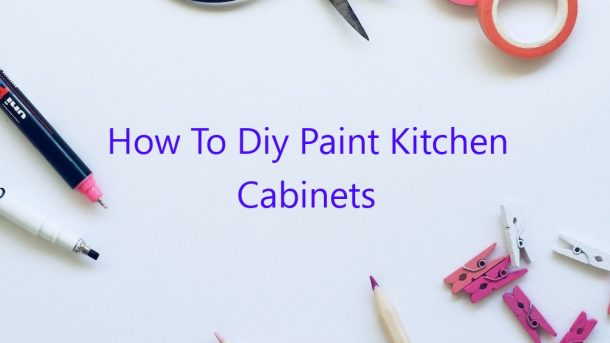If you’re looking to give your kitchen cabinets a fresh new look, painting them might be the way to go. Painting kitchen cabinets can be a relatively easy DIY project, and the results can be really impressive.
If you’re thinking of painting your kitchen cabinets, there are a few things you need to keep in mind. First, you’ll need to decide what color to paint them. If you’re not sure, you can take a look at some paint color charts, or you can go online and find inspiration.
Once you’ve chosen a color, you’ll need to decide what type of paint to use. There are a few different types of paint you can use, but latex paint is a good option for kitchen cabinets, because it’s durable and easy to clean.
Once you’ve chosen a color and type of paint, you’ll need to prepare the cabinets for painting. This involves sanding them down and cleaning them off, so the paint will adhere properly.
After the cabinets are prepped, it’s time to start painting. You’ll need to apply a few coats of paint, and let each coat dry completely before applying the next.
Once the paint is dry, you’ll need to install the hardware on the cabinets. This can be a bit tricky, so you might want to get some help from a friend.
Once the hardware is installed, your kitchen cabinets will be ready for use. Congratulations – you’ve just painted kitchen cabinets!
Contents [hide]
Can I paint my kitchen cabinets on my own?
Yes, you can paint your kitchen cabinets on your own, but it’s not always easy. Here’s a guide on how to do it.
First, remove all of the cabinet doors and drawers and lightly sand them down. This will remove any debris or dirt and will help the paint adhere better.
Next, prime the cabinets with a good-quality primer. This will help to ensure that the paint adheres evenly and will help to prevent any peeling or chipping.
Once the primer has dried, apply a coat of paint to the cabinets. Be sure to use a good-quality paint, as this will help to ensure a longer-lasting finish.
Finally, reattach the doors and drawers and enjoy your newly painted cabinets!
What kind of paint do you use to paint over kitchen cabinets?
When painting over kitchen cabinets, there are a few things you need to keep in mind. The type of paint you use will affect the finished product, so it’s important to choose the right one.
The two most common types of paint used for this purpose are latex and oil-based. Latex paint is a water-based paint that is easy to apply and is less likely to cause fumes than oil-based paint. It is also less expensive. However, latex paint is not as durable as oil-based paint and may not be suitable for high-traffic areas.
Oil-based paint is more durable than latex paint and is less likely to fade in sunlight. However, it is more expensive and can be more difficult to apply. It also has more fumes than latex paint.
When choosing paint for kitchen cabinets, it is important to consider the type of surface you are painting. If the cabinets are made of wood, you will need to use a paint that is designed for wood. If the cabinets are made of metal, you will need to use a paint that is designed for metal.
It is also important to choose the right color. The best way to choose a color is to take into account the color of the walls and the floor. You may also want to consider the color of the appliances and the cabinets.
Once you have chosen the right paint and the right color, it is time to start painting. Be sure to follow the instructions on the paint can carefully. Apply a coat of primer to the cabinets before you start painting. This will help the paint to adhere to the surface and will also help to prevent the paint from peeling.
If you are not sure which type of paint to use or which color to choose, consult a professional painter. He or she will be able to help you choose the right paint and the right color for your kitchen cabinets.
Can I just paint over old paint on cabinets?
If you’re looking for a quick and easy way to give your cabinets a fresh new look, you may be considering just painting over the old paint. This can be a tempting option, but it’s not always the best choice. In most cases, it’s best to remove the old paint before painting the cabinets.
There are a few reasons why you should remove the old paint before painting the cabinets. First, it’s important to make sure that the surface is clean and smooth before painting. If you paint over the old paint, you may end up with a lot of bumps and ridges. Second, the old paint may not be adhering well to the surface, which could lead to peeling or chipping. Finally, the old paint may contain harmful chemicals that can be released into the air when you paint over it.
If you decide to remove the old paint, there are a few ways to do it. You can use a chemical paint stripper, a sandpaper, or a power washer. If you choose to use a chemical paint stripper, be sure to follow the manufacturer’s instructions carefully. Sanding and power washing are both effective methods, but they can be a bit more labor-intensive.
Once the old paint is removed, you can proceed to paint the cabinets using the paint of your choice. Be sure to choose a paint that is designed for cabinets, and follow the manufacturer’s instructions for application. If you’re not sure which paint to choose, consult a professional painter.
In most cases, it’s best to remove the old paint before painting the cabinets. However, if you decide to paint over the old paint, be sure to choose the right paint and follow the manufacturer’s instructions carefully.
Can you paint over kitchen cabinets without sanding?
Can you paint over kitchen cabinets without sanding?
Yes, you can paint over kitchen cabinets without sanding. However, it is important to properly prepare the surface before painting.
First, remove all cabinet doors and hardware. Wash the cabinets with a degreaser, then sand them lightly with a sandpaper. Finally, apply a coat of primer before painting.
Should I use a brush or roller to paint cabinets?
When painting cabinets, there are a few things to consider when deciding whether to use a brush or a roller.
Brushes are good for getting into tight spaces, and they can also be used to create a textured finish. Rollers are good for covering large areas quickly.
If you are using a brush, it is important to make sure that the paint is thin enough to spread easily. If the paint is too thick, it will not spread evenly and will likely drip.
If you are using a roller, you should make sure that the paint is thin enough to spread easily. If the paint is too thick, it will not spread evenly and may drip.
In general, it is usually easier to achieve a smooth finish with a roller. However, it is important to make sure that the paint is thin enough so that it will not drip.
What happens if you don’t sand cabinets before painting?
Cabinets are an important part of any kitchen or bathroom. They provide storage, and they can also be a focal point in the room. If you’re looking to give your cabinets a new look, one option is to paint them. However, if you don’t sand them before painting, you may end up with a finish that’s not as smooth as you wanted.
When you paint cabinets without sanding them first, you may end up with a finish that’s not as smooth as you wanted.
One reason to sand cabinets before painting is to remove any dust or dirt from the surface. This will help the paint adhere better and will result in a smoother finish.
Another reason to sand cabinets is to create a rough surface for the paint to adhere to. If you don’t do this, the paint may not stick to the cabinet and may start to peel or chip.
If you don’t sand your cabinets before painting them, you may end up with a finish that’s not as smooth as you wanted. The paint may also start to peel or chip. Therefore, it’s important to sand your cabinets before painting them to ensure a smooth finish.
Do I need to prime cabinets before painting?
There are a lot of variables when it comes to painting cabinets. Whether you prime them first or not is one of those questions that has no definitive answer.
Some painters will tell you that priming is always necessary, while others say that it’s only necessary if the cabinets are made from a material that is not paintable, such as raw wood. In most cases, though, primer will help the paint adhere better to the surface and will help to create a more even finish.
If you do choose to prime your cabinets, there are a few things to keep in mind. Primer should be applied in thin coats, and it’s important to allow each coat to dry completely before applying the next. You’ll also want to be sure to use a primer that is specifically designed for cabinets, as this type of primer will provide the best adhesion.
If you decide not to prime your cabinets, it’s still important to make sure that the surface is clean and free of any dirt or grease. You can do this by washing the cabinets with a degreaser or a mild soap and water solution.
Once the cabinets are clean, you can begin painting. Be sure to use a high-quality paint and to apply it in thin, even coats. Allow each coat to dry completely before applying the next.




